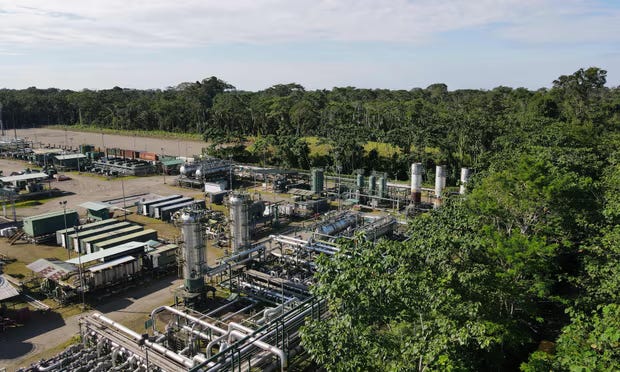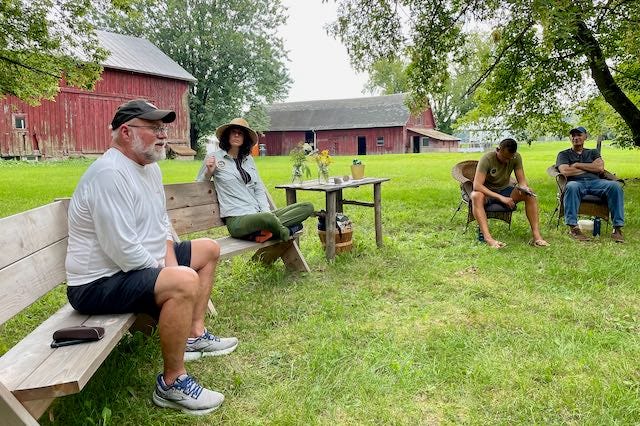Refugia Newsletter #48
Hawaii, Montana, Ecuador, the IRA, glorious fungi, a Dutch lake, and farm refugia
Refugia News
My least favorite season of the academic year is August Panic. And that’s where we are right now. Classes at Calvin University begin next week—yikes! I always feel better after the first week of classes are behind us. All of you teachers out there: I see you.
Besides launching my courses in the next few weeks, I’ll be recording a couple more episodes of the Green Lectionary podcast sponsored by Creation Justice Ministries. The first episode drops on August 28 and you can find a teaser here. I’ll be recording another episode for the BioLogos podcast, too, this one a kind of virtual book club with two other guest speakers. We’ll be discussing Robin Wall Kimmerer’s Braiding Sweetgrass. (Here’s an earlier episode I did with them, back in 2022.) I will of course let you know when the new episode drops.
Meanwhile, I’ll be spending most of my time frantically class-prepping and grading grading grading.
Pro tip: Always have a plushie William Shakespeare and a skull on hand. The John Calvin bobblehead is, of course, optional.
And… a quick reminder: The discount code Refugia23 will still work until August 31 for a 25% discount on Refugia Faith. Just click below and enter the code at checkout.
This Week in Climate News
The Summer of a New and Scary Reality continues. From an article in The New Yorker:
Around the world, summer heat, drought, floods, and fire now pose such grave and intertwined threats to life and property that Kristina Dahl, a climate researcher with the Union of Concerned Scientists, has argued that summer should be renamed “danger season.” Are we approaching the end of another summer, or the end of summer as we know it?
Because so much is happening, we’re going to do four news stories today, and—believe it or not—three of them are good news!
First, Hawaii. Obviously, this is the bad news. It all happened so fast on August 8. Thanks to a perfect storm of brush fire, high winds from Hurricane Dora, downed power lines, and some apparent serious missteps on the part of city officials, the whole area of Lahaina, on Maui, is a tragic ash heap. You’ve seen the footage. The fire is “now confirmed as the site of the deadliest U.S. wildfire in more than a century, with more than 100 deaths confirmed. The vast majority of the remains have not yet been identified. Two weeks after the fire, more than 1,000 people remain unaccounted for.” That’s according to an AP news article with a very helpful illustrated timeline of the event.
What is less well covered in the news is the environmental justice element here. We know that heat, drought, and ocean storms are intensified by climate change. But the area’s history of colonial exploitation created the underlying conditions. In an excellent article in Heated, Emily Atkin interviews an indigenous Hawaiian person, Kaniela Ing, who explains that Lahaina used to be a wetland. Sugar and pineapple barons drained the area to create plantations and brought in invasive grasses that are more tindery than native plants. Hence, the stage was set over centuries of colonization for this month’s disaster. Will the “recovery” offer opportunity for some healing of that colonial past? Remains to be seen.
Image credit: AFP | Julia Han JANICKI, Sophie RAMIS/enca.com
Now for the good news. Three stories.
Held v. Montana.
I gasped aloud when I heard this news. They won! The sixteen young people who filed Held v. Montana have won their case in court. Is it a big deal? Yes.
On August 14, Judge Kathy Seely of the Montana District Court ruled that the state needs to take into account long-term climate impacts when considering permitting of fossil fuel projects. This is in a red state, full of coal and gas development, that has never in decades denied a permit for a fossil fuel project.
The state of Montana had previously passed a law that “actually prohibits state agencies from considering climate change impacts when their licensing and approving fossil fuel development for coal mines, for oil and gas development.”
To contest the law, according to an article by Gabriel Furshong in The Nation, the sixteen young people sued,
claiming that Montana’s permissive approach to fossil-fuel mining, drilling, and combustion violated their constitutional rights. On June 12, their case became the first youth climate case to go to trial in US history. And on August 14, they won.
… [The judge] declared that the state violated their constitutional rights to equal protection, dignity, liberty, health and safety, and public trust—all of which, she determined, are predicated on their right to a clean and healthful environment.
For these reasons, she declared unconstitutional the state laws prohibiting Montana agencies from considering climate change or greenhouse gas emissions when permitting fossil fuel activities. …
Will this ruling make a difference? “It’s going to make other judges braver,” predicts Anne Hedges, policy director for the Montana Environmental Information Center (MEIC). Other state law suits are in the works, including one set for trail in Hawaii next year. Of course, this ruling will be appealed by the state of Montana. Nevertheless, analysts are optimistic that the ruling is a breakthrough. In an interview with Inside Climate News, legal scholar Pat Parenteau remarked that Judge Seely has written an excellent ruling, carefully establishing precedent that other judges can draw from. She “has built the strongest, what we’d call evidentiary record, that any court has done.”
Look how young they are! It’s breathtaking. “Eleven of the 16 youth plaintiffs in the Held v. Montana case pose for a photo after Day 5 of the trial on Friday, June 16, 2023. Top row (left to right): Lander Busse, Badge Busse, Grace, Rikki Held, Olivia. Bottom row (left to right): Kian, Mica, Claire, Eva, Taleah, Sariel.” [Image credit and caption, washingtonstatestandard.com, Photo by Blair Miller, Daily Montanan]
Happy anniversary, IRA!
You may have glimpsed the sploosh of coverage celebrating the one-year mark for the Inflation Reduction Act, which was passed August 16, 2022—by a hair, with zero Republican votes, as you’ll recall. The White House and Democrats are unified in praising the accomplishments of the bill. The White House officially claims that
The law has already created over 170,000 good-paying and union jobs in clean energy manufacturing, and it is projected to create more than 1.5 million additional jobs over the next decade according to estimates by outside groups.
The IRA has already been incredibly successful in spurring investments in green energy, manufacturing, and more. The initial effects haven’t quite made it to most people’s day-to-day, though. Americans are confused: many don’t know much about the law, according to polls, though they do love the provisions about reducing drug costs (yeah, it’s a complicated bill). Republicans want to get rid of the climate provisions while also taking credit for investments in their districts.
Outside the US, however, the significance of the IRA is becoming clearer. I listened to two very wonky podcasts this week. (Note: podcasts on global economics? what is happening to me??) One podcast was an Ezra Klein interview with Martin Wolf (a Brit), a former senior economist at the World Bank among other things. The other podcast was a Volts interview with Saul Griffith (an Aussie), co-founder of Rewiring America among other things. Both Wolf and Griffith had some critiques of the bill’s details. But both also noted its hugely significant positive effects, even after only a year, in catalyzing the globe’s efforts to address climate change. Griffith was willing to say that the IRA is more important than the Paris Agreement in actually bringing change.
Here’s one non-American data analysis firm’s projections. Source: woodmac.com
Ecuador
Speaking of power to the people, the people of Ecuador voted overwhelmingly (60% to 40%) to stop oil drilling in the Yasuni National Park, a 2.5 million-acre region in the Amazon rain forest. The Ecuadoran state oil company has one year to move out of this biodiverse region, which is also critical to several indigenous groups, and provide remediation and reforestation.
Here’s a quote from the CNN coverage:
Mitch Anderson, executive director of the non-profit Amazon Frontlines, said in a statement: “In one fell swoop, the Ecuadorian people struck a mighty blow to the oil industry, protected one of the most biodiverse forests in the Amazon, and showed the world what grassroots climate action really looks like.”
Of course, oil and government officials warned of all the cash the loss of 57,000 barrels a day would entail. The people of Ecuador basically said: “Don’t care. Other things are more important.”
“A Petroecuador oil processing centre in Yasuní national park.” The sort of place that will have to be removed if we’re going to leave oil in the ground and protect biodiversity.
[Image and caption credit: theguardian.com: Photograph: Rodrigo Buendía/AFP/Getty Images.]
Deeper Dive
That was a lot of news. So we’ll keep the Deeper Dive short. Let’s talk about the glory of fungi.
Apparently, fungi can help us prevent forest fires. In order to thin out forests to make them less ignitable, forest managers are using IRA money (yes!) to thin them by selective cutting. But…
The challenge now is what to do with all those piles of sticks, which create fire hazards of their own. Some environmental scientists believe they have an answer: mushrooms. Fungus has an uncommon knack for transformation. Give it garbage, plastic, even corpses, and it will convert them all into something else — for instance, nutrient-rich soil.
This article by Stephen Robert Miller in The Washington Post explains how mycologists and forest managers are experimenting with using mushrooms on a large scale to break down the slash (cut-up trees) in a few years rather than a few decades. The result is fantastically rich soil.
Another homage to fungi: I’m completely fascinated by this story by Anna Marija Helt in JSTOR Daily on nineteenth-century women who did botanical illustrations… of fungi. Yes, it was a thing. I mean, how cool is that? These women weren’t exactly admired for this work, but they did it anyway. The article is worth a read for sure.
Is that gorgeous, or what??
[Image credit: daily.jstor.org: “From Fungi of Maryland by Mary Elizabeth Banning”]
Refugia Sighting
Sometimes, humans have to create refugia in order to repair damage done by forebears. And who better to create refugia than a bunch of Dutch eco-engineers? This Dutch project aims to restore a big lake by creating “marker wadden.” Here’s the explanation from the Natuurmonumenten website:
Natuurmonumenten (Dutch Society for Nature Conservation) and Rijkswaterstaat (the executive agency of the Ministry of Infrastructure and Water Management) are restoring one of the largest freshwater lakes in western Europe by constructing islands, marshes and mud flats from the sediments that have accumulated in the lake in recent decades. These 'Marker Wadden' will form a unique ecosystem that will boost biodiversity in the Netherlands.
Lake Markermeer (700 km2) was split off from Lake IJsselmeer in 1976, when a dam was built between Enkhuizen and Lelystad. Disconnected from the sea and rivers, the lake became a stagnant system. The lake has barely any natural shores, and its waters are often extremely turbid as wind and waves churn up the accumulated sediments from the relatively shallow lake floor (2-4 m deep). As a result, fish and bird populations have declined dramatically. The construction of this archipelago, these new islands give nature a major boost with newly created habitats for water plants, shellfish, birds and fish. Islands with natural shores and spawning areas will be built with sand, clay and silt dredged from the lake. This way a robust, clear-watered nature area arises in the heart of the Netherlands: a natural jewel where migrating birds, fish and other animals will thrive.
Source: https://www.natuurmonumenten.nl/
The Wayback Machine
My friend Nurya Love Parish invited a number of people to Plainsong Farm last week, all of us working in the “climate space” here in West Michigan. Some of us knew each other, some didn’t. The idea was to get together and figure out ways to support each other. Hanging out there again reminded me of the first time I visited Plainsong, a faith-based farm initiative striving to reconnect Christians to the land. I wrote this essay back in 2020 to describe what Plainsong is up to. It’s a remarkable refugia space that continues to evolve and thrive.
A few of us gather last weekend at Plainsong Farm to support each other in our work on climate in West Michigan.
Whatever transitions you’re in the midst of, I hope you find support and grace. Till next time, be well.











